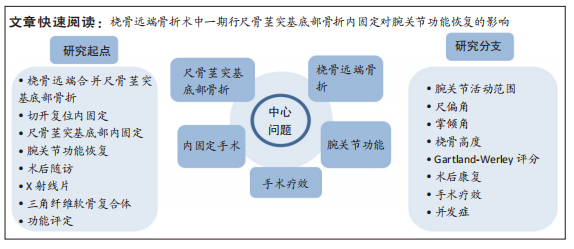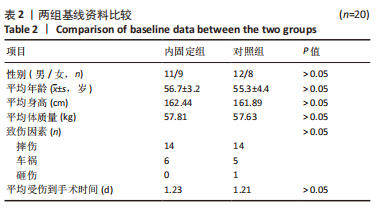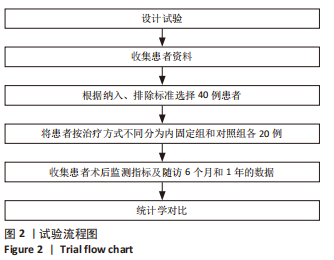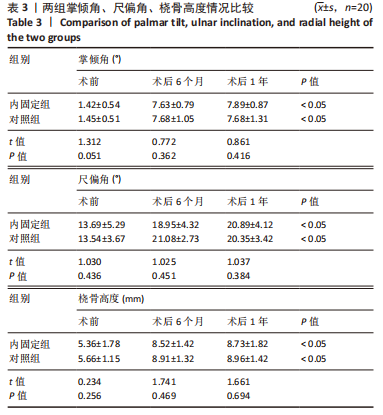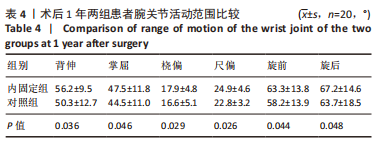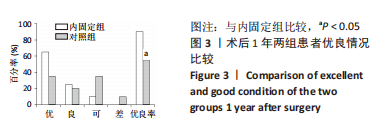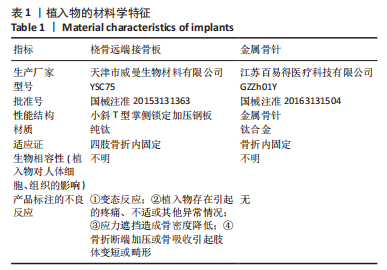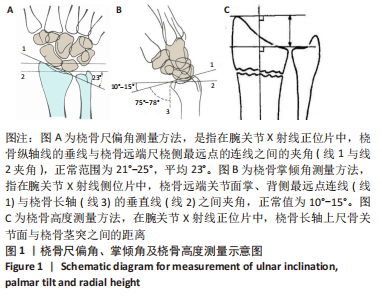[1] 郑上团,吴斗,郝海虎,等.桡骨远端骨折的治疗进展[J].中华骨科杂志,2016,36(5):314-320.
[2] 姜保国,张殿英,付中国,等.桡骨远端骨折的治疗建议[J].中华创伤骨科杂志,2010,12(11):1053-1056.
[3] WYSOCKI RW, RUCH DS. Ulnar styloid fracture with distal radius fracture. J Hand Surg Am. 2012;37(3):568-569.
[4] 徐春归,张积森,许新忠,等.合并尺骨茎突骨折对桡骨远端骨折钢板内固定术后功能恢复的影响[J].临床骨科杂志,2019,22(4): 466-470.
[5] 吴佳俊,王子平,易存国,等.桡骨远端骨折内固定治疗预后与尺骨茎突骨折的相关临床分析[J].生物骨科材料与临床研究,2018, 15(6):52-54.
[6] 张俊,厉国定,尹伟忠,等.尺骨茎突骨折与否及不同分型对桡骨远端骨折术后疗效的影响[J].中国骨与关节损伤杂志,2019,34(3): 321-323.
[7] 董加纯,尹望平,陈延超,等.尺骨茎突骨折固定与否对桡尺远侧关节旋转稳定性的影响[J].中华手外科杂志,2015,31(4):266-268.
[8] KIM JK, YUN YH, KIN DJ, et al. Comparison of United and Nonunited Fractures of the Ulnar Styloid Following Volar-Plate Fixation of Distal Radius Fractures. Injury. 2011;42(4):371-375.
[9] CHEN AC, CHIU CH, WENG CJ, et al. Early and late fixation of ulnar styloid base fractures yields different outcomes. J Orthop Surg Res. 2018;13(1):193-197.
[10] 张超,谢雪涛,胡顺东,等.尺骨茎突骨折对桡骨远端骨折内固定术后腕关节功能的影响[J].国际骨科学杂志,2016,37(4):264-266.
[11] GARTLANDJJ JR, WERLEY CW. Evaluation of healed Collesfractures. J Bone Joint Surg Am. 1951;33:895-907.
[12] ADAMS BD. Effects of radial deformity on distal radioulnar joint mechanics. J Hand Surg Am. 1993;18(3):492-498.
[13] 李晓,侯忠军,于胜军,等.探讨具有手术指征的特殊类型的尺骨茎突骨折[J].实用手外科杂志,2017,31(1):108-109.
[14] 关启.切开复位内固定治疗桡骨远端骨折不同类型尺骨茎突骨折的最终效果[J].临床研究,2019,28(11):66-67.
[15] FRYKMAN G. Fracture of the distal radius including sequelae -shoulder -hand -finger syndrome,disturbance in the distal radio -ulnar jointand impairment of nerve function:a clinical and experimental study.Acta Orthop Scand. 1967;108(Suppl):3.
[16] Lindau T, Hagherg L, Adlercreutz C, et al. Distal radioulnar instability is an independent worsening factor in distal radial fractures. Clin Orthop Relat Res. 2000;(376):229-230.
[17] 郑晓勇,任昕宇,赵东升,等.尺骨茎突基底部骨折的治疗方式对腕关节功能的影响[J].创伤外科杂志,2014,1(1):14-16.
[18] 刘小智,宋坤修,马丙栋,等.桡骨远端骨折桡侧移位对桡尺远侧关节稳定性的影响[J].中华手外科杂志,2019,35(6):4.
[19] 危涛,王勤业,罗亚平,等.两种内固定治疗桡骨远端骨折伴尺骨茎突基底部骨折的疗效比较[J].临床骨科杂志,2021,24(2):257-260.
[20] MAY MM, LAWTON JN, BLAZAR PE. Ulnar styloid fractures associ-ated with distal radius fractures:incidence and implications for distal radioulnar joint instability. J Hand Surg Am. 2002;27(6):965-971.
[21] LUTSKY KF, LUCENTI L, BEREDJIKLIAN PK. Outcomes of distal ulna fractures associated with operatively treated distal radius fractures. Hand (N Y). 2020;15(3):418-421.
[22] 徐春归,张积森,许新忠,等.合并尺骨茎突骨折对桡骨远端骨折钢板内固定术后功能恢复的影响[J].临床骨科杂志,2019,22(4): 466-470.
[23] LICHTMAN DM, BINDRA RR, BOYER MI, et al. American academy of orthopaedic surgeons clinical practice guideline on: the treatment of distal radius fractures. J Bone Joint Surg Am. 2011;93(8):775-778.
[24] 周强,陆骅,王占朝,等.生物可吸收张力带治疗尺骨茎突骨折的评价[J].中国组织工程研究,2013,17(25):4733- 4738.
[25] PARDLWALA D, PRABHU V, DUDHMIWALA G, et al. The AO distal locking aimingdevice: an evaluation of efficacy and learning CRllve. Injury. 2001;32:713.
|
